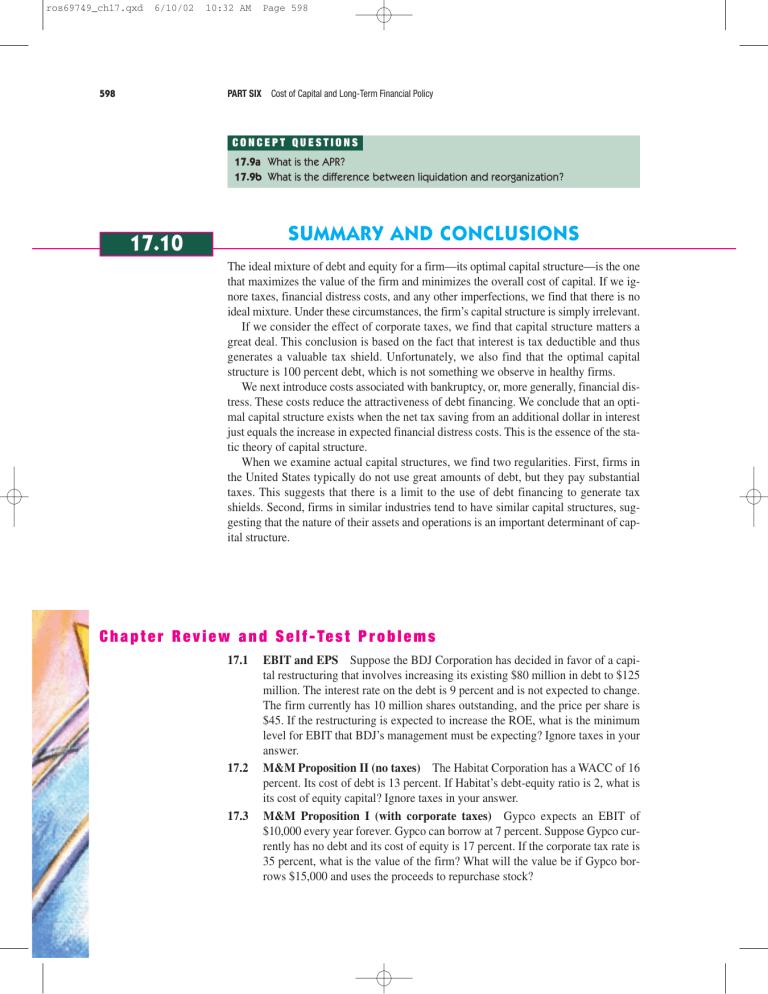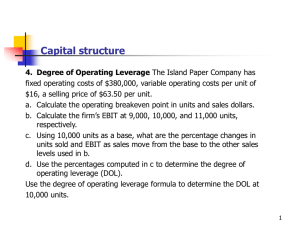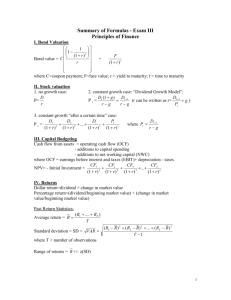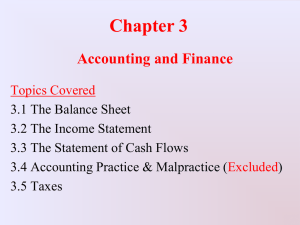17.10 SUMMARY AND CONCLUSIONS

ros69749_ch17.qxd 6/10/02 10:32 AM Page 598
598
17.10
PART SIX Cost of Capital and Long-Term Financial Policy
C O N C E P T Q U E S T I O N S
17.9a
What is the APR?
17.9b
What is the difference between liquidation and reorganization?
SUMMARY AND CONCLUSIONS
The ideal mixture of debt and equity for a firm—its optimal capital structure—is the one that maximizes the value of the firm and minimizes the overall cost of capital. If we ignore taxes, financial distress costs, and any other imperfections, we find that there is no ideal mixture. Under these circumstances, the firm’s capital structure is simply irrelevant.
If we consider the effect of corporate taxes, we find that capital structure matters a great deal. This conclusion is based on the fact that interest is tax deductible and thus generates a valuable tax shield. Unfortunately, we also find that the optimal capital structure is 100 percent debt, which is not something we observe in healthy firms.
We next introduce costs associated with bankruptcy, or, more generally, financial distress. These costs reduce the attractiveness of debt financing. We conclude that an optimal capital structure exists when the net tax saving from an additional dollar in interest just equals the increase in expected financial distress costs. This is the essence of the static theory of capital structure.
When we examine actual capital structures, we find two regularities. First, firms in the United States typically do not use great amounts of debt, but they pay substantial taxes. This suggests that there is a limit to the use of debt financing to generate tax shields. Second, firms in similar industries tend to have similar capital structures, suggesting that the nature of their assets and operations is an important determinant of capital structure.
C h a p t e r R e v i e w a n d S e l f - Te s t P r o b l e m s
17.1
EBIT and EPS Suppose the BDJ Corporation has decided in favor of a capital restructuring that involves increasing its existing $80 million in debt to $125 million. The interest rate on the debt is 9 percent and is not expected to change.
The firm currently has 10 million shares outstanding, and the price per share is
$45. If the restructuring is expected to increase the ROE, what is the minimum level for EBIT that BDJ’s management must be expecting? Ignore taxes in your answer.
17.2
M&M Proposition II (no taxes) The Habitat Corporation has a WACC of 16 percent. Its cost of debt is 13 percent. If Habitat’s debt-equity ratio is 2, what is its cost of equity capital? Ignore taxes in your answer.
17.3
M&M Proposition I (with corporate taxes) Gypco expects an EBIT of
$10,000 every year forever. Gypco can borrow at 7 percent. Suppose Gypco currently has no debt and its cost of equity is 17 percent. If the corporate tax rate is
35 percent, what is the value of the firm? What will the value be if Gypco borrows $15,000 and uses the proceeds to repurchase stock?
ros69749_ch17.qxd 6/10/02 10:32 AM Page 599
CHAPTER 17 Financial Leverage and Capital Structure Policy 599
A n s w e r s t o C h a p t e r R e v i e w a n d S e l f - Te s t P r o b l e m s
17.1
To answer, we can calculate the break-even EBIT. At any EBIT above this, the increased financial leverage will increase EPS. Under the old capital structure, the interest bill is $80 million
⫻
.09
⫽
$7,200,000 . There are 10 million shares of stock, so, ignoring taxes, EPS is (EBIT
⫺
$7.2 million)/10 million.
Under the new capital structure, the interest expense will be $125 million
⫻
.09
⫽
$11.25 million . Furthermore, the debt rises by $45 million. This amount is sufficient to repurchase $45 million/$45
⫽
1 million shares of stock, leaving
9 million outstanding. EPS is thus (EBIT
⫺
$11.25 million)/9 million.
Now that we know how to calculate EPS under both scenarios, we set the two calculations equal to each other and solve for the break-even EBIT:
(EBIT
⫺
$7.2 million)/10 million
⫽
(EBIT
⫺
$11.25 million)/9 million
EBIT
⫺
$7.2 million
⫽
1.11
⫻
(EBIT
⫺
$11.25 million)
EBIT
⫽
$47,700,000
Verify that, in either case, EPS is $4.05 when EBIT is $47.7 million.
17.2
According to M&M Proposition II (no taxes), the cost of equity is:
R
E
⫽
R
A
⫹
( R
A
⫺
R
D
)
⫻
( D / E )
⫽
16%
⫹
(16%
⫺
13%)
⫻
2
⫽
22%
17.3
With no debt, Gypco’s WACC is 17 percent. This is also the unlevered cost of capital. The aftertax cash flow is $10,000
⫻
(1
⫺
.35)
⫽
$6,500 , so the value is just V
U
⫽
$6,500/.17
⫽
$38,235 .
After the debt issue, Gypco will be worth the original $38,235 plus the present value of the tax shield. According to M&M Proposition I with taxes, the present value of the tax shield is T
C
⫻
D , or .35
⫻
$15,000
⫽
$5,250 , so the firm is worth $38,235
⫹
5,250
⫽
$43,485 .
C o n c e p t s R e v i e w a n d C r i t i c a l T h i n k i n g Q u e s t i o n s
1.
Business Risk versus Financial Risk Explain what is meant by business and financial risk. Suppose Firm A has greater business risk than Firm B. Is it true that Firm A also has a higher cost of equity capital? Explain.
2.
M&M Propositions How would you answer in the following debate?
Q: Isn’t it true that the riskiness of a firm’s equity will rise if the firm increases its use of debt financing?
A: Yes, that’s the essence of M&M Proposition II.
Q: And isn’t it true that, as a firm increases its use of borrowing, the likelihood of default increases, thereby increasing the risk of the firm’s debt?
A: Yes.
Q: In other words, increased borrowing increases the risk of the equity and the debt?
A: That’s right.
Q: Well, given that the firm uses only debt and equity financing, and given that the risks of both are increased by increased borrowing, does it not follow
ros69749_ch17.qxd 6/10/02 10:32 AM Page 600
600 PART SIX Cost of Capital and Long-Term Financial Policy that increasing debt increases the overall risk of the firm and therefore decreases the value of the firm?
A: ??
3.
Optimal Capital Structure Is there an easily identifiable debt-equity ratio that will maximize the value of a firm? Why or why not?
4.
Observed Capital Structures Refer to the observed capital structures given in Table 17.7 of the text. What do you notice about the types of industries with respect to their average debt-equity ratios? Are certain types of industries more likely to be highly leveraged than others? What are some possible reasons for this observed segmentation? Do the operating results and tax history of the firms play a role? How about their future earnings prospects? Explain.
5.
Financial Leverage Why is the use of debt financing referred to as financial
“leverage”?
6.
Homemade Leverage What is homemade leverage?
7.
Bankruptcy and Corporate Ethics As mentioned in the text, some firms have filed for bankruptcy because of actual or likely litigation-related losses. Is this a proper use of the bankruptcy process?
8.
Bankruptcy and Corporate Ethics Firms sometimes use the threat of a bankruptcy filing to force creditors to renegotiate terms. Critics argue that in such cases, the firm is using bankruptcy laws “as a sword rather than a shield.” Is this an ethical tactic?
9.
Bankruptcy and Corporate Ethics As mentioned in the text, Continental
Airlines filed for bankruptcy, at least in part, as a means of reducing labor costs.
Whether this move was ethical, or proper, was hotly debated. Give both sides of the argument.
10.
Capital Structure Goal What is the basic goal of financial management with regard to capital structure?
Q u e s t i o n s a n d P r o b l e m s
Basic
(Questions 1–15)
1.
EBIT and Leverage Control, Inc., has no debt outstanding and a total market value of $100,000. Earnings before interest and taxes, EBIT, are projected to be
$6,000 if economic conditions are normal. If there is strong expansion in the economy, then EBIT will be 30 percent higher. If there is a recession, then EBIT will be 60 percent lower. Control is considering a $40,000 debt issue with a
5 percent interest rate. The proceeds will be used to repurchase shares of stock.
There are currently 2,500 shares outstanding. Ignore taxes for this problem.
a.
Calculate earnings per share, EPS, under each of the three economic scenarios before any debt is issued. Also, calculate the percentage changes in EPS when the economy expands or enters a recession.
b.
Repeat part ( a ) assuming that Control goes through with recapitalization.
What do you observe?
2.
EBIT, Taxes, and Leverage Repeat parts ( a ) and ( b ) in Problem 1 assuming
Control has a tax rate of 35 percent.
3.
ROE and Leverage Suppose the company in Problem 1 has a market-to-book ratio of 1.0.
ros69749_ch17.qxd 6/10/02 10:32 AM Page 601
CHAPTER 17 Financial Leverage and Capital Structure Policy a.
Calculate return on equity, ROE, under each of the three economic scenarios before any debt is issued. Also, calculate the percentage changes in ROE for economic expansion and recession, assuming no taxes.
b.
Repeat part ( a ) assuming the firm goes through with the proposed recapitalization.
c.
Repeat parts ( a ) and ( b ) of this problem assuming the firm has a tax rate of
35 percent.
4.
Break-Even EBIT Linkin Park Corporation is comparing two different capital structures, an all-equity plan (Plan I) and a levered plan (Plan II). Under
Plan I, Linkin Park would have 100,000 shares of stock outstanding. Under
Plan II, there would be 50,000 shares of stock outstanding and $1.5 million in debt outstanding. The interest rate on the debt is 10 percent and there are no taxes.
a.
If EBIT is $200,000, which plan will result in the higher EPS?
b.
If EBIT is $700,000, which plan will result in the higher EPS?
c.
What is the break-even EBIT?
5.
M&M and Stock Value In Problem 4, use M&M Proposition I to find the price per share of equity under each of the two proposed plans. What is the value of the firm?
6.
Break-Even EBIT and Leverage Taylor Corp. is comparing two different capital structures. Plan I would result in 800 shares of stock and $9,000 in debt.
Plan II would result in 700 shares of stock and $13,500 in debt. The interest rate on the debt is 10 percent.
a.
Ignoring taxes, compare both of these plans to an all-equity plan assuming that EBIT will be $8,000. The all-equity plan would result in 1,000 shares of stock outstanding. Which of the three plans has the highest EPS? The lowest?
b.
In part ( a ), what are the break-even levels of EBIT for each plan as compared to that for an all-equity plan? Is one higher than the other? Why?
c.
Ignoring taxes, when will EPS be identical for Plans I and II?
d.
Repeat parts ( a ), ( b ), and ( c ) assuming that the corporate tax rate is 40 percent. Are the break-even levels of EBIT different from before? Why or why not?
7.
Leverage and Stock Value Ignoring taxes in Problem 6, what is the price per share of equity under Plan I? Plan II? What principle is illustrated by your answers?
8.
Homemade Leverage Zombie, Inc., a prominent consumer products firm, is debating whether or not to convert its all-equity capital structure to one that is 40 percent debt. Currently, there are 1,000 shares outstanding and the price per share is $70. EBIT is expected to remain at $7,000 per year forever. The interest rate on new debt is 7 percent, and there are no taxes.
a.
Ms. Spears, a shareholder of the firm, owns 100 shares of stock. What is her cash flow under the current capital structure, assuming the firm has a dividend payout rate of 100 percent?
b.
What will Ms. Spears’s cash flow be under the proposed capital structure of the firm? Assume that she keeps all 100 of her shares.
c.
Suppose Zombie does convert, but Ms. Spears prefers the current all-equity capital structure. Show how she could unlever her shares of stock to recreate the original capital structure.
d.
Using your answer to part ( c ), explain why Zombie’s choice of capital structure is irrelevant.
Basic
( continued )
601
ros69749_ch17.qxd 6/10/02 10:32 AM Page 602
602
Basic
( continued )
Intermediate
(Questions 16–17)
PART SIX Cost of Capital and Long-Term Financial Policy
9.
Homemade Leverage and WACC ABC Co. and XYZ Co. are identical firms in all respects except for their capital structure. ABC is all-equity financed with
$600,000 in stock. XYZ uses both stock and perpetual debt; its stock is worth
$300,000 and the interest rate on its debt is 10 percent. Both firms expect EBIT to be $85,000. Ignore taxes.
a.
Ms. Aaliyah owns $45,000 worth of XYZ’s stock. What rate of return is she expecting?
b.
Show how Ms. Aaliyah could generate exactly the same cash flows and rate of return by investing in ABC and using homemade leverage.
c.
What is the cost of equity for ABC? What is it for XYZ?
d.
What is the WACC for ABC? For XYZ? What principle have you illustrated?
10.
M&M J Lo Corp. uses no debt. The weighted average cost of capital is 14 percent. If the current market value of the equity is $40 million and there are no taxes, what is EBIT?
11.
M&M and Taxes In the previous question, suppose the corporate tax rate is
35 percent. What is EBIT in this case? What is the WACC? Explain.
12.
Calculating WACC Nopay Industries has a debt-equity ratio of 2. Its WACC is 11 percent, and its cost of debt is 11 percent. The corporate tax rate is 35 percent.
a.
What is Nopay’s cost of equity capital?
b.
What is Nopay’s unlevered cost of equity capital?
c.
What would the cost of equity be if the debt-equity ratio were 1.5? What if it were 1.0? What if it were zero?
13.
Calculating WACC Molly Corp. has no debt but can borrow at 9 percent. The firm’s WACC is currently 15 percent, and the tax rate is 35 percent.
a.
What is Molly’s cost of equity?
b.
If the firm converts to 25 percent debt, what will its cost of equity be?
c.
If the firm converts to 50 percent debt, what will its cost of equity be?
d.
What is Molly’s WACC in part ( b )? In part ( c )?
14.
M&M and Taxes Maria & Co. expects its EBIT to be $80,000 every year forever. The firm can borrow at 14 percent. Maria currently has no debt, and its cost of equity is 25 percent. If the tax rate is 35 percent, what is the value of the firm?
What will the value be if Maria borrows $50,000 and uses the proceeds to repurchase shares?
15.
M&M and Taxes In Problem 14, what is the cost of equity after recapitalization? What is the WACC? What are the implications for the firm’s capital structure decision?
16.
M&M Bruin Manufacturing has an expected EBIT of $26,000 in perpetuity, a tax rate of 35 percent, and a debt-equity ratio of .60. The firm has $60,000 in outstanding debt at an interest rate of 8 percent, and its WACC is 12 percent.
What is the value of the firm according to M&M Proposition I with taxes?
Should Bruin change its debt-equity ratio if the goal is to maximize the value of the firm? Explain.
17.
Firm Value Bellevue Corporation expects an EBIT of $6,000 every year forever. Bellevue currently has no debt, and its cost of equity is 16 percent. The firm can borrow at 10 percent. If the corporate tax rate is 35 percent, what is the value of the firm? What will the value be if Bellevue converts to 50 percent debt? To 100 percent debt?
ros69749_ch17.qxd 6/10/02 10:32 AM Page 603
CHAPTER 17 Financial Leverage and Capital Structure Policy
18.
Weighted Average Cost of Capital In a world of corporate taxes only, show that the WACC can be written as WACC
⫽
R
U
⫻
[1
⫺
T
C
( D / V )].
19.
Cost of Equity and Leverage Assuming a world of corporate taxes only, show that the cost of equity, R
E
, is as given in the chapter by M&M Proposition
II with corporate taxes.
20.
Business and Financial Risk Assume a firm’s debt is risk-free, so that the cost of debt equals the risk-free rate, R f
. Define

A is, the systematic risk of the firm’s assets. Define

E as the firm’s asset beta, that to be the beta of the firm’s equity. Use the capital asset pricing model, CAPM, along with M&M Proposition II to show that

E
⫽ 
A
⫻
(1
⫹
D / E ), where D / E is the debt-equity ratio.
Assume the tax rate is zero.
21.
Stockholder Risk Suppose a firm’s business operations are such that they mirror movements in the economy as a whole very closely, that is, the firm’s asset beta is 1.0. Use the result of Problem 20 to find the equity beta for this firm for debt-equity ratios of 0, 1, 5, and 20. What does this tell you about the relationship between capital structure and shareholder risk? How is the shareholders’ required return on equity affected? Explain.
Challenge
(Questions 18–21)
603
1.
Capital Structure Find the annual balance sheets for Pfizer (PFE), Ford (F), and McDonald’s (MCD). For each company, calculate the long-term debt-toequity ratio for the two most recent years. Why would these three companies use such different capital structures?
S & P P r o b l e m
17.1
Capital Structure Go to yahoo.marketguide.com and enter the ticker symbol
AMGM for Amgen, a biotechnology company. Follow the “Ratio Comparison” link and find long-term debt-to-equity and total debt-to-equity ratios. How does
Amgen compare to the industry, sector, and S&P 500 in these areas? Now answer the same question for Edison International (EIX), the parent company of
Southern California Edison, a utility company. How do the capital structures of
Amgen and Edison International compare? Can you think of possible explanations for the difference between these two companies?
17.2
Capital Structure Go to www.amex.com and follow the “Screening” link.
Using the debt-to-equity screener, how many companies have debt-to-equity ratios greater than 2? Greater than 5? Greater than 10? What company has the highest debt-to-equity ratio? What is the ratio? Now find how many companies have a negative debt-to-equity ratio. What is the lowest debt-to-equity ratio?
What does it mean if a company has a negative debt-to-equity ratio?
17.3
Capital Structure Go to www.amex.com and follow the “Screening” link.
Using the total assets-to-equity ratio, how many companies have a total asset-toequity ratio greater than 5? Greater than 10? Greater than 20? What does a high total asset-to-equity ratio imply for the debt-to-equity ratio? How many companies have a total asset-to-equity ratio that is negative? What company has the lowest total asset-to-equity ratio? What does a negative total asset-to-equity ratio imply for the debt-to-equity ratio?
What’s On the Web?
ros69749_ch17.qxd 6/10/02 10:32 AM Page 604
604 PART SIX Cost of Capital and Long-Term Financial Policy
17.4
Bankruptcies Go to www.abiworld.org and follow the “Bankruptcy Headlines” link. How many companies filed for bankruptcy on this day?
12
10
11
8
9
6
7
4
5
3
1
2
If we inve for the u
A
Using a s preadshe st $25,0 nknown o
Present V
Future V
Rate (rate
) alue (pv) alue (fv)
Periods: f periods
B et for tim e value o
00 at 12 p ercent, h
C
, so we u se the fo
D f money c alculatio ns ow long u ntil we h rmal NPE
E ave $50,0
R (rate, p
$25,000
$50,000
F
00? We n mt, pvfv)
13
14
The form has a neg al entered ative sig
in cell B n on it. A
10 is = N lso notic
0.12
PER: notic e that rate
is entere
6.116255
e that pm d as dec imal, not a
percenta ge.
G
H
Spreadsheet Templates 17–6, 17–12






